Jet Boat
What Is a Jet Boat? The Complete Definition!
You'll be amazed by how jet boats harness water for speed and maneuverability—discover their unique features and history now!

A jet boat is a unique watercraft that uses jet propulsion to move swiftly across rivers and shallow waters. It ejects water from the stern, which allows for exciting speeds of up to 50 knots. You can navigate in as little as 3 inches of water, making it great for exploring tricky spots. Its enclosed impeller system enhances safety by reducing injury risks. Plus, with fewer moving parts, maintenance is easier and costs are lower. The impressive handling and maneuverability make jet boats popular for adventure tourism and racing. Curious about their features and history? There's more to discover!
Key Takeaways
- Jet boats use jet propulsion, ejecting water from the stern for forward movement and enhanced maneuverability.
- They can navigate shallow waters as low as 7.5 cm (3 inches), minimizing hull damage risks.
- With high-speed capabilities reaching up to 50 knots, they offer thrilling experiences for users.
- Jet boats feature an enclosed impeller system, increasing safety by reducing injury risks from external rotating parts.
Definition of Jet Boat
A jet boat is a type of vessel that uses a powerful jet of water ejected from the stern to propel itself forward. This innovative design relies on jet propulsion rather than traditional propellers, which gives you several advantages.
Unlike boats with exposed propellers, jet boats utilize an enclosed impeller system. This not only enhances safety by reducing the risk of injuries but also improves performance, allowing for faster acceleration and better handling.
One of the standout features of jet boats is their ability to navigate shallow waters. You can operate in depths as low as 7.5 cm (3 inches) without damaging the hull, making them ideal for exploring rivers and lakes where other boats can't go.
Their high-speed capabilities often allow you to reach speeds of up to 50 knots, providing an exhilarating experience. Additionally, the design of jet boats eliminates protruding components below the hull. This means you can glide through narrow passages with ease, minimizing the risk of hull strikes.
Historical Background
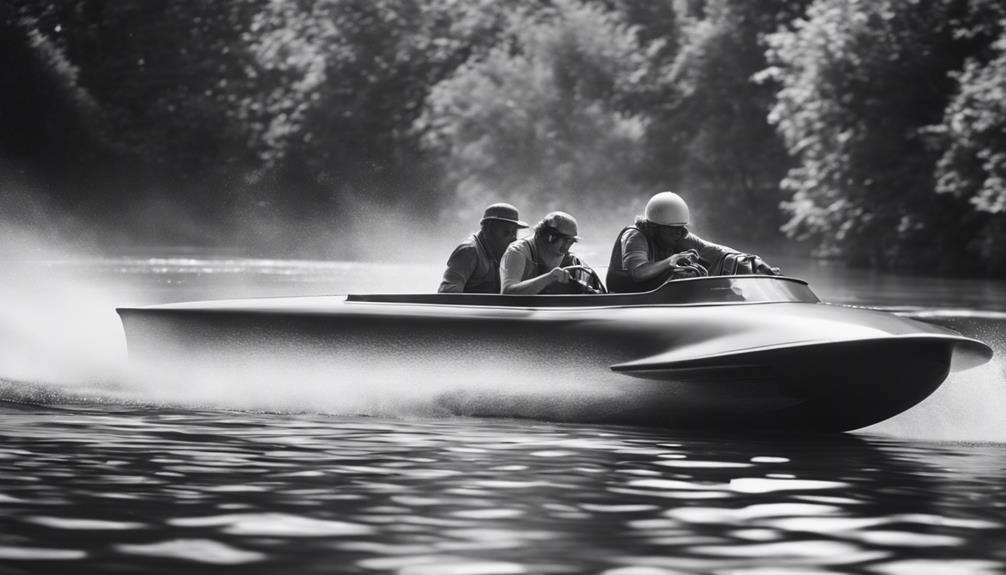
The evolution of jet boats traces back to the mid-1950s when Sir William Hamilton sought to enhance navigation in New Zealand's shallow rivers. His innovative approach led to the development of the first jet unit, which utilized a Ford engine and a bevel gear-operated pump. This significant advancement laid the groundwork for modern jet propulsion designs in boating.
Early jet boats, while inspired by American designs, were customized to perform better in shallow waters. This adaptation marked a pivotal moment in marine technology, allowing these vessels to navigate areas where traditional propeller-driven boats struggled. By the 1990s, the popularity of jet boats surged, largely due to advancements in engine technology and the growing interest in recreational boating.
Key milestones in the historical background of jet boats include:
- Sir William Hamilton's pioneering designs in the 1950s.
- The introduction of the first jet unit with a Ford engine.
- Adaptations from American designs for enhanced shallow water performance.
These developments showcase the ongoing innovations in marine engineering and jet propulsion systems that continue to shape the industry today.
Mechanics of Jet Boats

Jet boats rely on a water jet propulsion system to generate thrust, drawing water in and expelling it through a nozzle.
You'll find that steering is achieved by directing this jet stream, which makes these boats incredibly agile.
With fewer moving parts than traditional propeller systems, jet boats also require less maintenance, enhancing their overall efficiency.
Propulsion System Explained
Water jet propulsion systems power jet boats by drawing in water from beneath the hull and expelling it at high velocity through a nozzle at the stern, creating thrust and exceptional maneuverability. This propulsion system isn't just efficient but also enhances safety by enclosing the impeller within a housing, preventing direct contact with spinning components.
Here are some key features of jet boat propulsion systems:
- Shallow Water Operation: Jet boats can navigate in as little as 7.5 cm (3 inches) of water, making them perfect for tight spots.
- Single-Stage Units: Most modern jet boats utilize single-stage jet units for streamlined performance.
- Multi-Stage Designs: Older models may feature multi-stage designs to optimize power in different conditions.
Understanding the intricacies of the propulsion system helps you appreciate how jet boats excel in performance and versatility, enabling thrilling adventures on the water.
Steering and Maneuverability
Effective steering in jet boats relies on directional thrust generated by adjusting the nozzle, allowing you to make sharp turns and execute rapid stops with ease. Unlike traditional propeller-driven boats, jet boats need the engine to be running for steering, so you'll always have that engine humming while you navigate.
The unique propulsion system gives you impressive control, even in shallow waters as shallow as 7.5 cm (3 inches). This capability allows you to explore areas where other boats can't go, enhancing your overall experience. When you need to maneuver in tight spaces, you can utilize reverse thrust by lowering a deflector into the jet stream, redirecting thrust forces to move backward smoothly.
Additionally, the hull design of jet boats plays an essential role in their high-speed cornering control and stability. This makes them not only fun for recreational use but also effective in tactical operations.
With a jet boat, you can confidently navigate various water conditions, knowing that your steering and maneuverability are optimized for performance. Whether you're making quick turns or stopping suddenly, jet boats are engineered to meet your needs on the water.
Performance Characteristics

When you think about jet boats, their unique propulsion mechanism stands out, enabling impressive speed and efficiency.
You'll notice how their design allows for incredible maneuverability and stability, making them perfect for steering through tight spaces.
Let's explore how these features come together to enhance your overall boating experience.
Propulsion Mechanism Explained
Jet boats rely on a powerful water jet propulsion system that draws in water from beneath the hull, accelerates it through impellers, and expels it at high speed through a stern nozzle, delivering impressive thrust and maneuverability.
This innovative jet propulsion technology allows you to enjoy thrilling speeds of up to 50 knots, making jet boats ideal for both recreational and tactical uses.
Here are some key performance characteristics of jet propulsion systems in jet boats:
- Shallow Water Operation: Jet boats can navigate in as little as 7.5 cm (3 inches) of water, reducing the risk of hull damage.
- Responsive Steering: You can steer by adjusting the direction of the jet stream, which enhances control.
- Quick Stops: The ability to generate reverse thrust using deflectors allows for effective low-speed maneuvers.
With these features, jet propulsion in jet boats guarantees you'll have an exhilarating experience while maintaining safety and control on various water conditions.
Maneuverability and Stability
The unique design of jet boats not only enhances their propulsion capabilities but also greatly improves their maneuverability and stability on the water. With a shallow draft, these boats can operate in just 7.5 cm (3 inches) of water, making them perfect for traversing tight spaces. The lack of protruding components below the hull reduces drag, allowing for quick acceleration and efficient navigation in shallow waters.
Steering in a jet boat is achieved through the directional control of the water jet, which enables you to make rapid turns and crash stops without needing large turning radii. You'll appreciate how jet boats can perform high-speed cornering while still maintaining stability, thanks to their flat bottom hull design and water jet propulsion system.
Additionally, the implementation of reverse thrust by redirecting the jet stream enhances low-speed maneuverability, giving you better control even in challenging conditions. Whether you're dodging obstacles or making sharp turns, jet boats excel in delivering a responsive and stable ride, making them an excellent choice for those who crave adventure on the water.
Advantages of Jet Boats
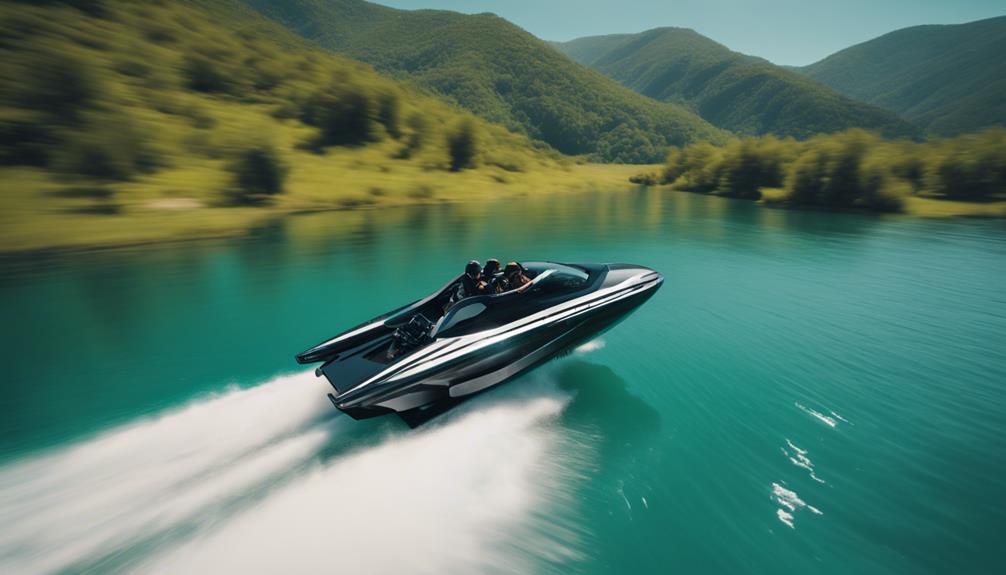
One major advantage of jet boats is their ability to navigate in extremely shallow waters, with a minimum depth of just 7.5 cm (3 inches), opening up areas that traditional boats simply can't access. This capability allows you to explore unique waterways and hidden gems that others can't reach.
Additionally, jet boats feature a propulsion system that expels water from the stern, eliminating external components like propellers. This design reduces the risk of damage to underwater obstacles and marine life, making jet boats a safer choice for nature enthusiasts.
Here's why you'll love jet boats:
- Exceptional Maneuverability: They can execute sharp turns and rapid stops, enhancing safety in tight spaces.
- High-Speed Thrills: With speeds up to 50 knots, they offer exhilarating experiences for adventure seekers.
- Low Maintenance: Fewer moving parts mean lower ownership costs and less time spent on upkeep.
With these advantages, jet boats provide a unique blend of excitement and practicality, making them a fantastic option for both leisure and exploration.
Limitations of Jet Boats
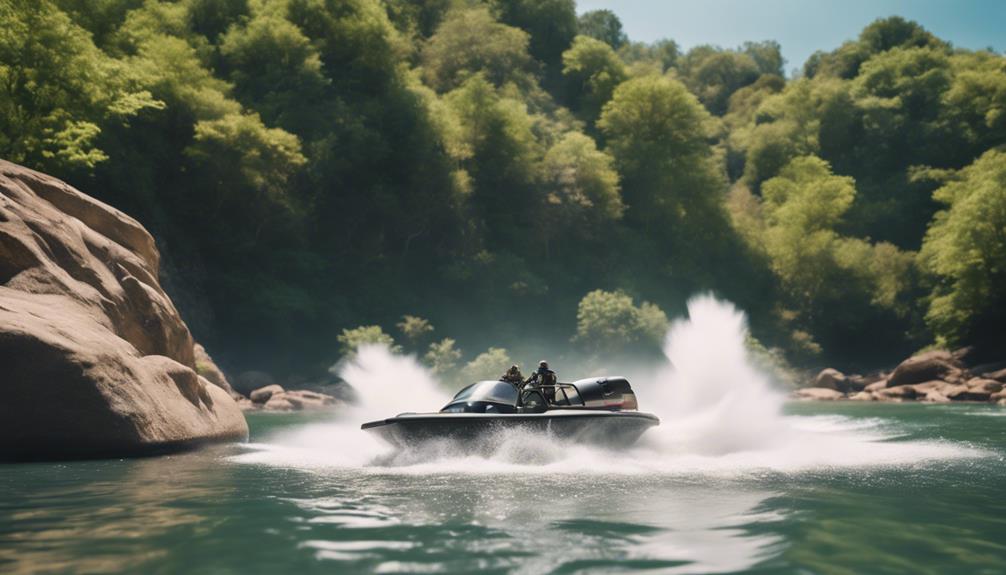
While jet boats offer unique advantages, they do have notable limitations.
You might find their top speed lacking compared to propeller-driven boats, which can be a drawback if you're chasing high performance.
Additionally, expect a rougher ride in choppy waters and some steering challenges at low speeds that could affect your maneuverability.
Speed Limitations Compared to Propellers
Jet boats often struggle with speed compared to propeller-driven boats due to their smaller engines and the inherent limitations of jet propulsion systems at high speeds. While they perform well at lower speeds, these speed limitations become pronounced as you push the throttle. You'll find that jet boats can't quite match the top speeds of larger, more powerful propeller-driven vessels.
Here are a few key points to take into account:
- Jet boats usually have smaller engines, which caps their maximum speed.
- Jet propulsion systems are less efficient at high speeds, limiting performance.
- Their lightweight design may result in instability, affecting speed in rough conditions.
Understanding these speed limitations is vital when deciding between a jet boat and a propeller-driven alternative.
If you're looking for thrilling high-speed adventures, a propeller boat might be your best bet. However, if you prioritize shallow water navigation and nimble handling at lower speeds, a jet boat could be the right choice for you.
Rough Ride in Choppy Waters
Steering through choppy waters in a jet boat can be quite a bumpy experience, often leading to discomfort for passengers due to its lightweight design.
Unlike heavier boats, jet boats lack a traditional keel, which limits their ability to cut through waves effectively. This results in a ride that's bouncier and less stable in rough conditions.
While advancements have enhanced slow-speed handling, jet boats still rely heavily on directional thrust. This makes them more susceptible to instability when the waters get turbulent.
You might find that maneuvering choppy seas requires more skill and attention, as jet boats can be less forgiving than their propeller-driven counterparts.
At high speeds, jet boats may struggle to maintain comfort, especially in rough seas. The impeller-driven propulsion system is optimized for low-speed maneuverability, but when the waters get rough, you may feel every wave.
Operators must be attentive and adjust their steering to keep control. If you're considering a jet boat for your adventures, it's crucial to be aware of these limitations and prepare for a potentially rough ride in choppy waters.
Steering Challenges at Low Speeds
Maneuvering a jet boat at low speeds presents unique challenges due to its reliance on directional thrust for steering. Unlike traditional boats that use rudders, jet boats depend on the flow of water through the jet unit to guide their movements. When you're operating at slow speeds, the reduced water flow can greatly diminish steering responsiveness and control.
Here are some challenges you might face:
- Difficulty executing precise turns
- Reduced ability to stop quickly
- Increased need for careful handling
You'll notice that the maneuverability of your jet boat is best at higher speeds, making it a thrill to navigate swiftly. However, as you slow down, that performance drops, necessitating extra caution and skill.
While technological advancements have made improvements in slow-speed handling, the fundamental issues remain. So, when you're out on the water, keep in mind that maintaining control at lower speeds will require your full attention and a bit more throttle to get the jet unit working effectively.
Applications and Use Cases

These versatile boats are perfect for a variety of applications, from recreational river tours to critical military and rescue operations. If you're looking for an exhilarating way to explore scenic waterways, a jet boat offers the thrill you crave.
With their ability to maneuver in shallow waters, they make a great choice for back-country adventures, hunting trips, and traversing narrow passages where traditional boats struggle.
Jet boats have also found a significant role in military and rescue operations. Their high maneuverability allows them to operate in challenging environments, making them essential for quick response scenarios. When time is of the essence, these boats can transport personnel and equipment to remote areas that other vessels can't access.
Adventure tourism has surged with the rise of jet boat usage, offering tailored experiences for thrill-seekers in rugged wilderness settings like Hells Canyon. Whether you're fishing, farming, or exploring new territories, a jet boat provides the agility and speed needed to tackle diverse tasks.
With such a wide range of applications, it's no wonder jet boats are becoming a popular choice for both leisure and essential services.
Safety Features
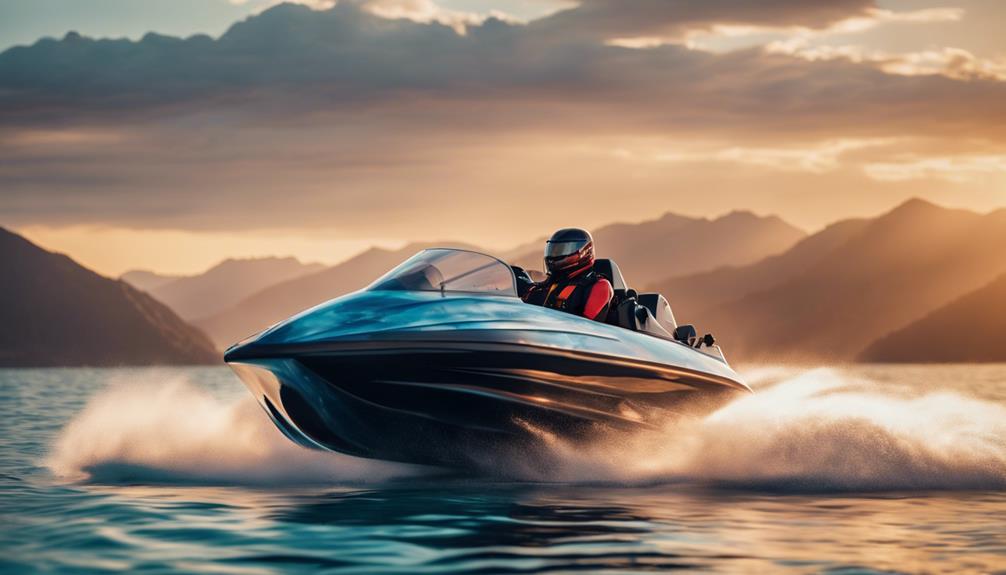
When exploring the thrilling applications of jet boats, it's important to contemplate their safety features, which considerably enhance your experience on the water. Jet boats are designed with several characteristics that prioritize your safety and that of your passengers.
- Enclosed impeller system: This minimizes the risk of swimmer injuries from spinning blades, making your outings safer.
- No external rotating parts: This reduces the likelihood of entanglement or injury to passengers and marine life, distinguishing jet boats from traditional propeller-driven vessels.
- Shallow water operation: Jet boats can navigate in very shallow waters—typically as shallow as 7.5 cm (3 inches)—which decreases the risk of hull strikes, allowing for safer exploration in tighter areas.
These safety features combine to provide a secure and enjoyable experience on the water, allowing you to focus on the excitement of your jet boat adventures without unnecessary worry.
Racing and Competitions
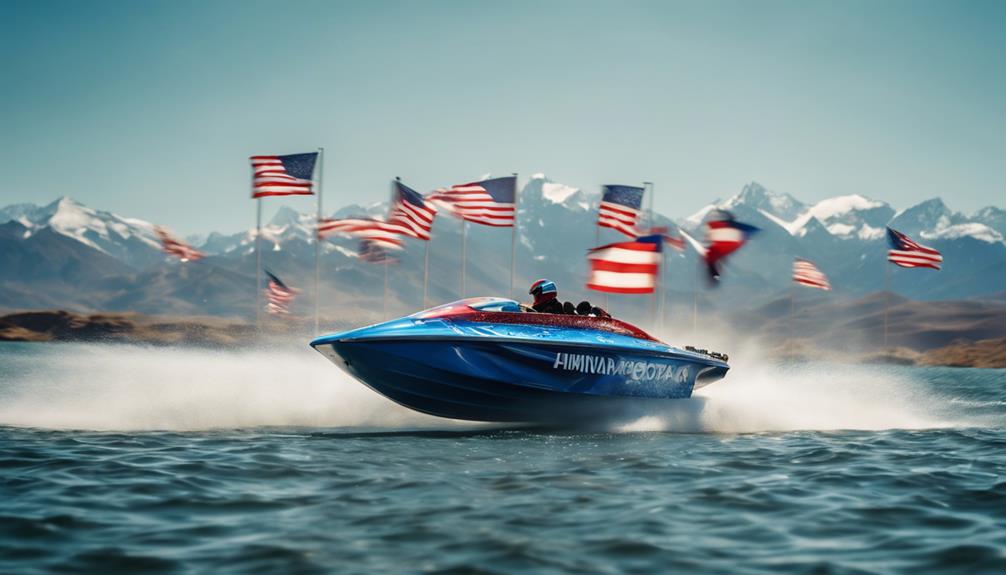
Jet boat racing captivates thrill-seekers, featuring high-speed competitions on rivers and specially designed sprint tracks across the globe. Whether you're in Mexico, Canada, the USA, or New Zealand, the adrenaline rush of watching these powerful machines navigate through challenging courses is unmatched. The World Champion Jet Boat Marathon stands out as one of the most prestigious events, showcasing various jet boat designs and their capabilities.
You'll notice that jet boat racing includes both recreational and professional categories, attracting enthusiasts from diverse backgrounds. The thrill lies in the jet boats' ability to execute rapid stops and sharp turns, which keeps both racers and spectators on the edge of their seats. Every twist and turn highlights the skill of the drivers and the advanced technology behind the boats.
As innovations in jet propulsion continue to evolve, the sport draws even more interest. With new designs and techniques emerging, you can expect the excitement of jet boat racing to grow. Whether you're a competitor or a spectator, the blend of speed, agility, and engineering makes jet boat racing an exhilarating experience you won't want to miss.
Cultural Impact and Significance

Racing isn't the only way jet boats influence our lives; their cultural impact and significance resonate through media, tourism, and the adventurous spirit they inspire.
You'll often see jet boats showcased in films and literature, symbolizing freedom and exploration as they glide through scenic waterways. This representation not only captures the thrill of adventure but also highlights a shift in boating technology, moving from traditional propeller-driven vessels to innovative water jet propulsion systems.
Jet boats play a crucial role in enhancing tourism, offering unique experiences that draw adventure seekers to picturesque locations. Here are a few ways they leave their mark:
- Adventure Tourism: Jet boats provide thrilling river tours and water sports experiences.
- Media Representation: They frequently appear in outdoor and adventure films, showcasing their excitement.
- Cultural Symbolism: Jet boats embody freedom and the spirit of exploration in various narratives.
In essence, jet boats are more than just vessels; they're a cultural phenomenon that reflects our desire for adventure.
Frequently Asked Questions
What Is Considered a Jet Boat?
A jet boat's considered a vessel that uses a water jet for propulsion instead of a propeller. You'll find it operates well in shallow waters and can reach high speeds, perfect for various activities.
Why Is It Called a Jet Boat?
When you hear “jet boat,” think of thrilling river adventures. It's called a jet boat because it uses water jet propulsion, allowing for high speeds and shallow navigation, setting it apart from traditional propeller-driven vessels.
What Is the Theory of Jet Boats?
The theory of jet boats revolves around Newton's third law: when water's expelled at high speed, it pushes the boat forward. You'll find their shallow draft lets you navigate tight spaces effortlessly.
What Is the Difference Between a Speed Boat and a Jet Boat?
The main difference between a speed boat and a jet boat lies in propulsion. Speed boats use propellers for movement, while jet boats rely on water jets, offering better maneuverability and performance in shallow waters.
Conclusion
In the world of watercraft, jet boats are like sleek arrows slicing through the waves, offering an exhilarating ride that's hard to forget.
You've explored their mechanics, advantages, and cultural significance, uncovering a vessel that's not just about speed but adventure and freedom.
So, whether you're traversing serene lakes or racing down rivers, jet boats invite you to embrace the thrill, turning every journey into a splash of excitement and a dance with the water's spirit.
Jet Boat
Will a Wake Shaper Work on a Jet Boat? The Facts Explained!
See how a wake shaper can transform your jet boat experience, but what specifics should you know before diving in?
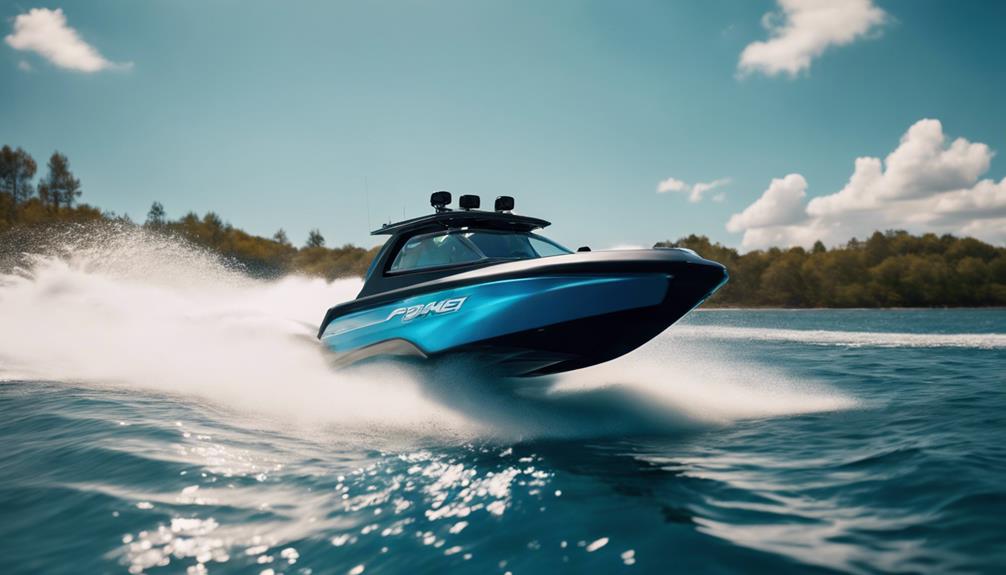
Yes, a wake shaper can work effectively on a jet boat, enhancing your wakesurfing experience. These devices help optimize wave shape and size by improving wave dynamics, especially when paired with proper ballast. For jet boats, a minimum ballast of 1200 lbs is recommended to achieve the best results. If you have a twin engine jet boat, you'll enjoy even greater control over wave adjustments. Products like the SWELL Wakesurf Creator are specifically designed for seamless integration with jet boats. Want to discover more about maximizing your wakesurf setup? There's plenty more to learn about optimizing your ride!
Key Takeaways
- Wake shapers significantly enhance wave size and quality on jet boats, particularly when paired with adequate ballast.
- Yamaha's wake shaper is specifically designed for 2018+ models, optimizing surf wave characteristics.
- Proper ballast placement (at least 1200 lbs) is crucial for effective performance with wake shapers on jet boats.
- Twin engine jet boats benefit from independent jet control, allowing for tailored wave shapes and improved surfing experiences.
Jet Boat Wakesurfing Overview
Jet boats are rapidly gaining traction in the wakesurfing community thanks to their unique design and performance capabilities. These boats offer a different experience compared to traditional inboard models. Their jet propulsion system allows for shallow water access and quick maneuverability, making them ideal for wakesurfing.
When you're wakesurfing behind a jet boat, the quality of the surf wave is heavily influenced by the boat's design. To achieve an ideal surfing experience, proper ballast placement is essential. You'll want to distribute weight effectively to create a more substantial wave.
Additionally, the introduction of wake shapers has revolutionized how you can enhance your wakesurfing sessions. A wake shaper can greatly improve the shape and size of the wave, allowing for a better ride.
For those with 2018 and newer models, Yamaha's wake shaper is specifically designed to enhance the wakesurf experience. However, as you explore compatibility with wake shapers like the SWELL Wakesurf Creator, it's vital to reflect on how your jet boat's setup interacts with these devices.
SWELL Wakesurf Creator Setup
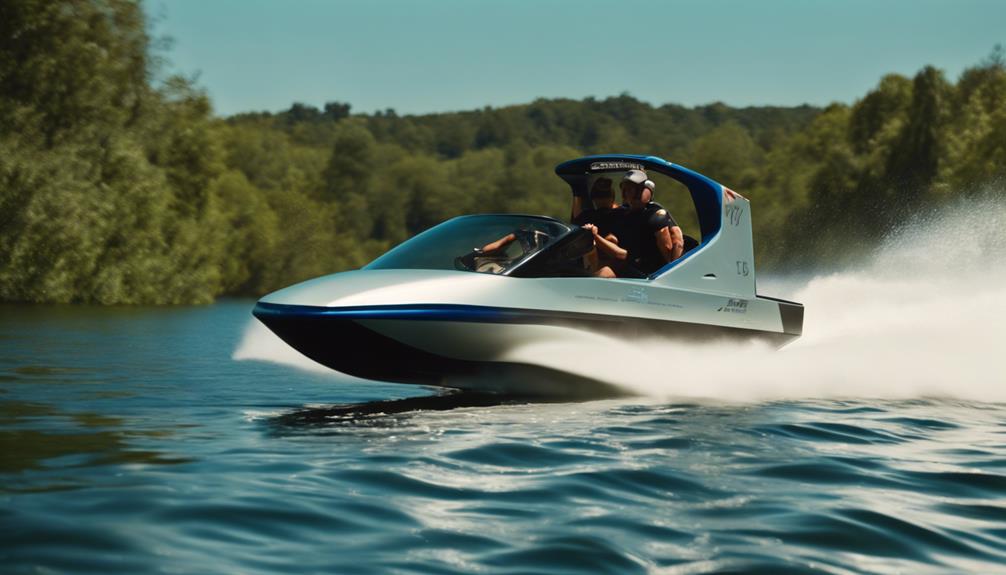
To enhance your wakesurfing experience with a jet boat, setting up the SWELL Wakesurf Creator correctly is key. The right setup can drastically improve your wave shape and size, making your sessions more enjoyable. For jet boats, the H3X Plus model is recommended for peak performance.
When mounting your swell wakesurf creator, verify you have a flat, decal-free surface, ideally below the waterline when the boat is loaded. Each unit needs a minimum space of 5 inches high by 13 inches long for effective installation. Here's a quick overview of important setup factors:
| Setup Factor | Recommendation |
|---|---|
| Model | H3X Plus |
| Minimum Space Required | 5 inches high x 13 inches long |
| Ideal Attachment Point | Below waterline when loaded |
Importance of Ballast
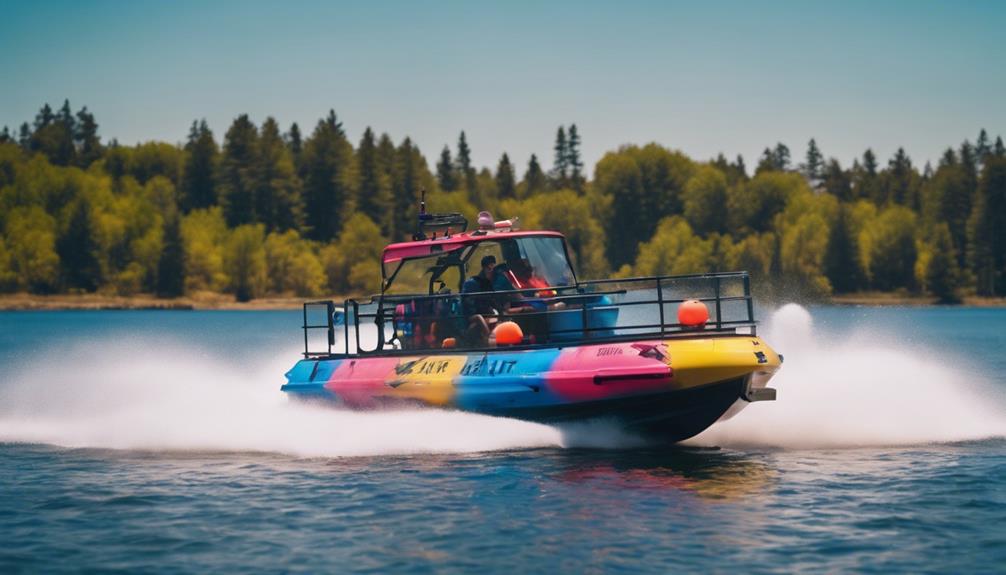
When it comes to creating the perfect surf wave, proper ballast placement is key.
You'll want to focus on ideal weight distribution, with about 60% in the rear and 40% in the front, to enhance wave size and overall performance.
Optimal Weight Distribution
Proper weight distribution is essential for achieving ideal wakesurfing conditions behind a jet boat, with at least 1200 lbs of ballast recommended for the best results.
Unlike traditional surf boats that often have 2000-2500 lbs of stock ballast, you'll find that jet boats require a more tailored approach to ideal weight distribution.
To create a larger and more defined surf wave, place your ballast as far back as possible. This rear ballast setup, ideally at a ratio of 60% rear to 40% front, enhances both wave quality and stability while you're out there wakesurfing.
Adding rear ballast, such as Transom Ballast Bags, can greatly boost the wake size and shape, improving your overall experience behind Yamaha Jet Boats (2017+ models).
Wave Size Enhancement
Enhancing wave size relies heavily on effective ballast management, as the right amount and placement of weight can dramatically improve your wakesurfing experience behind a jet boat. To achieve ideal wave size enhancement, consider these key factors:
- Minimum Ballast Requirement: Aim for at least 1200 lbs of ballast to create a sufficiently surfable wave.
- Weight Placement: Position additional ballast as far back in the boat as possible to maximize wave displacement.
For those using a Wakesurf Creator H3X Plus, remember that the addition of ballast directly influences your wave size. More weight typically leads to a larger and more defined wake, making your wakesurfing sessions much more enjoyable.
Jet boats often come with less stock ballast compared to modern surf boats, so investing in additional ballast is essential. By strategically managing your ballast, you can create a surfing wave that rivals those found on larger vessels, allowing you to catch more rides and have a blast on the water.
Benefits of Twin Engine Jet Boats

When you choose a twin engine jet boat, you gain independent control over each jet, allowing for precise adjustments to your surf wave.
This setup not only enhances wave quality but also accommodates a wider range of surfing abilities, making it enjoyable for everyone.
You'll find that better engine management translates to a more consistent and thrilling surfing experience.
Independent Jet Control
Independent jet control in twin engine jet boats lets you fine-tune each jet's performance, greatly improving the quality of waves for wakesurfing.
With the ability to throttle back the surf-side jet, you can enhance wave shape and size, creating a more enjoyable experience for everyone on the board. This independent control offers several advantages:
- Customizable Wave Shape: Adjust the thrust from each engine to create the perfect wave for your riding style.
- Consistent Performance: A more reliable surf wave means less frustration for both novice and experienced surfers alike.
Enhanced Wave Quality
Twin engine jet boats appreciably boost wave quality, making them a top choice for wakesurfing enthusiasts who crave a more defined and powerful surf experience. With the ability to control each jet independently, you can throttle back the surf-side jet, considerably enhancing wave quality. This feature allows for a tailored surf experience that single-engine models simply can't match.
Moreover, the central jet placement might present challenges, but with proper management, you can still create desirable surf waves. The improved weight distribution and maneuverability of twin engine setups also contribute to better overall wakesurfing experiences.
By incorporating a wake shaper, you can further optimize wave characteristics, generating larger and more defined wakes that are perfect for riding. It's essential to pay attention to ballast placement and weight management, as these factors directly impact wave size and surf capability.
Engine Management Benefits
How does effective engine management enhance your wakesurfing experience on a twin engine jet boat? With the ability to independently control each jet, you can make precise adjustments that greatly improve your surf wave's quality. Utilizing techniques like throttling back the jet on the surf side, you can create a more defined and cleaner wave, making it easier to ride without relying on the rope.
Consider these benefits of engine management in twin engine jet boats:
- Customizable Wave Shape: Adjusting each jet's output allows you to sculpt the wave according to your preferences.
- Enhanced Surfing Experience: A well-managed wave provides a better ride for surfers, improving overall enjoyment.
Recommended Wakesurf Products
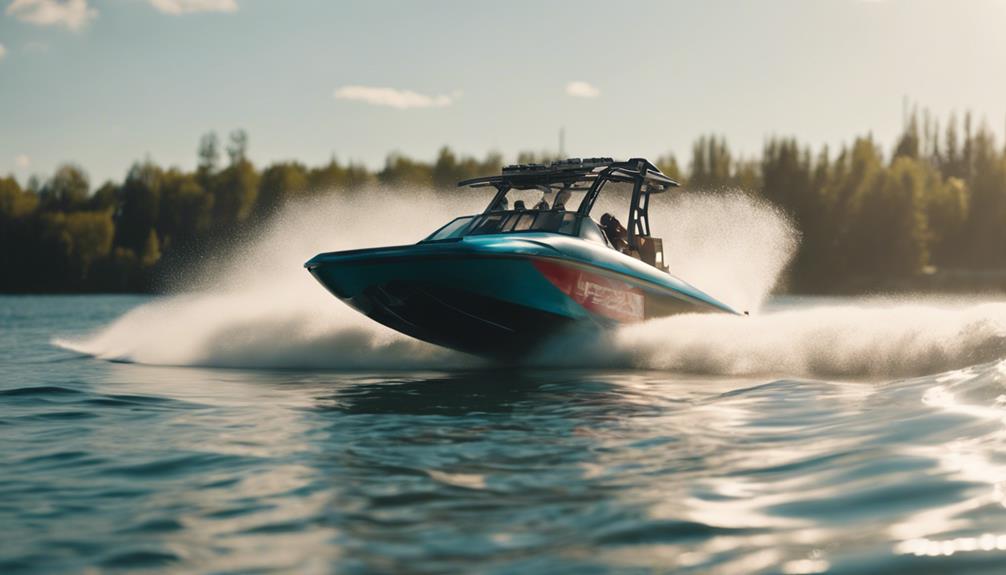
Choosing the right wakesurf products can greatly enhance your experience on jet boats, ensuring you get the best possible surf wave and performance.
The SWELL Wakesurf Creator Slim H3X is particularly effective for optimizing your jet boat's surf wave quality. It's designed to work seamlessly, providing a more enjoyable ride.
Another excellent option is the Liquid Force Wake Shaper. This product is adaptable for use on various watercraft, including jet skis like Yamaha Wave Runners, making it a versatile addition to your setup. It enhances wake dynamics, helping you achieve that perfect wave.
You might also consider adding ballast to your jet boat. Transom Ballast Bags, like the Flyhigh FatSac, can considerably improve your wake size and shape. Ideally, you should start with at least 1200 lbs of ballast for effective surfing performance, as modern surf boats often come with 2000-2500 lbs of stock ballast.
Lastly, the NautiCurl Flex Wake Shaper is a great tool to combat washout while wakesurfing. When paired with rear ballast, it can elevate your surfing experience, ensuring you get the best wave possible.
Safety in Wakesurfing
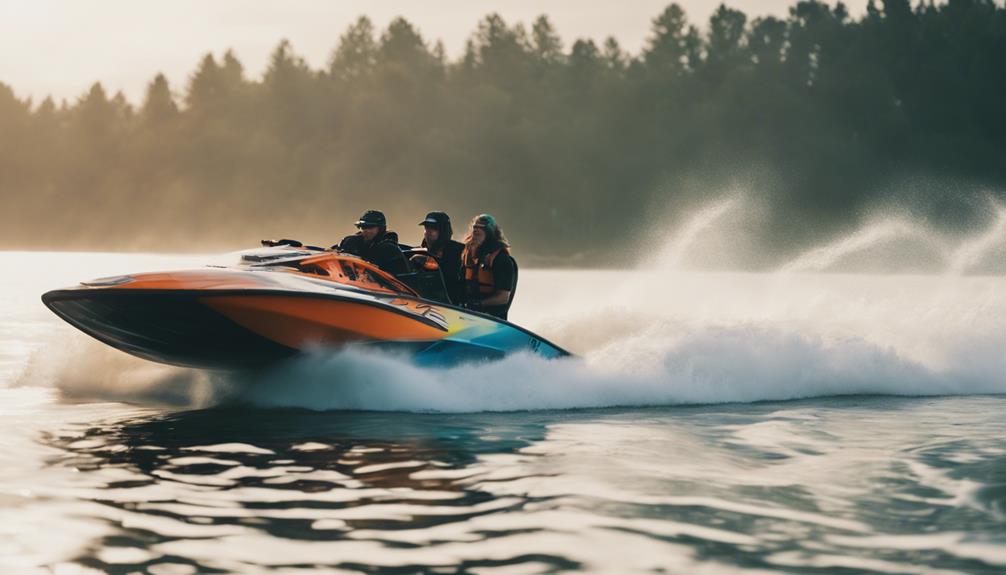
Safety in wakesurfing is paramount, and understanding the unique risks associated with jet boats can help you enjoy the sport more securely. While inboard jet boats provide the advantage of eliminating contact with external spinning blades, it's essential to manage other safety aspects effectively.
Here are some key safety tips to keep in mind:
- Proper boat setup: Make certain your boat is well-balanced, as an unstable jet boat can lead to accidents.
- Maintain distance: Stay 3 to 10 feet away from the boat's stern to avoid falls near propellers or jets.
Using a wake shaper can enhance your wave quality, but it's important to be cautious, as it might affect handling and safety when you're moving at high speeds.
By adhering to these safety practices, you can guarantee a more enjoyable wakesurfing experience while minimizing risks associated with jet boats.
Community Feedback and Insights

Community feedback reveals that many users have seen remarkable improvements in their wakesurfing experience after installing wake shapers on their jet boats. Users consistently mention that products like the SWELL Wakesurf Creator and the NautiCurl Flex Wake Shaper greatly enhance the size and quality of their wakes.
However, it's essential to recognize that adding adequate ballast is vital for maximizing these benefits. Most users recommend starting with at least 1200 lbs of ballast for ideal results. Many testimonials specifically highlight the effectiveness of wake shapers when used with Yamaha jet boats (2017 and newer) and transom ballast bags, creating perfect conditions for wakesurfing.
Online forums and social media platforms have become valuable spaces for sharing tips and personal experiences about wake shapers. Engaging with this community can provide insights into different setups and configurations, helping you make informed decisions.
Frequently Asked Questions
Can You Use a Wake Shaper on a Jet Boat?
Yes, you can use a wake shaper on a jet boat. To achieve the best results, make certain it's properly installed below the waterline and combine it with adequate ballast for a superior surfable wake.
Can You Wakeboard on a Jet Boat?
You can definitely wakeboard on a jet boat, but you'll need to add ballast for a better wake. Also, be cautious of the jet propulsion system while riding to guarantee safety during your session.
Can You Put a Wake Shaper on Any Boat?
Over 70% of wake surfers prefer optimized wakes for better performance. You can install a wake shaper on many boats, but compatibility varies. Ascertain proper setup and mounting for the best results on your specific vessel.
Do Wake Shapers Work?
Wake shapers do work by enhancing your boat's wake, allowing for better surfing experiences. However, their effectiveness depends on proper installation and the right ballast, so you'll need to adjust for ideal results.
Conclusion
In the end, using a wake shaper on a jet boat can be a game changer for wakesurfing.
Think of it like adding a turbocharger to a sports car; it enhances performance and creates an exhilarating experience.
Just like that car zipping around a track, you'll be carving waves with ease and style.
So, embrace the ride, invest in the right gear, and enjoy the thrill of wakesurfing on your jet boat.
Happy surfing!
Jet Boat
Why Does My Jet Boat Porpoise? Troubleshooting Tips!
Keep your jet boat cruising smoothly by discovering the surprising causes of porpoising and essential troubleshooting tips to enhance your ride!
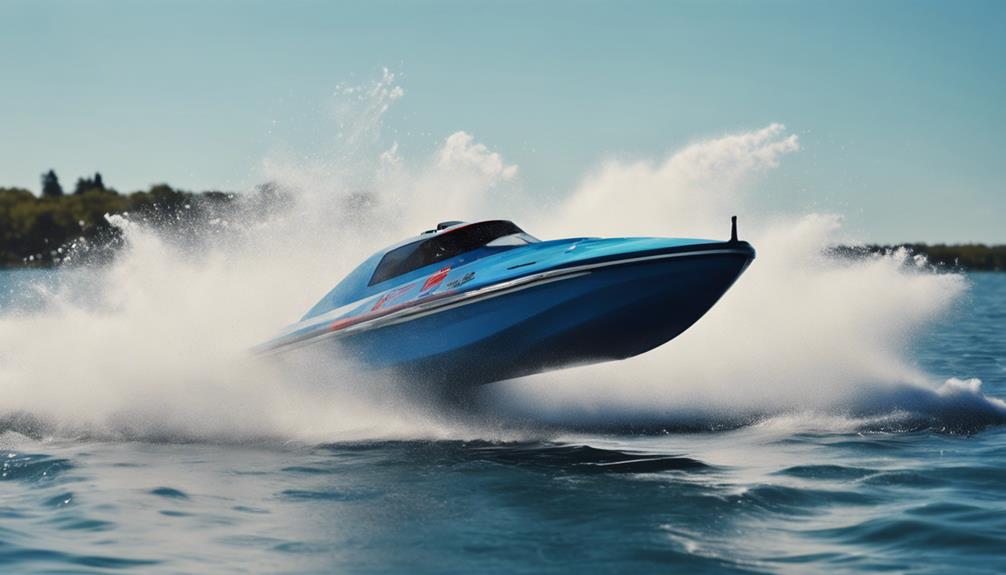
Your jet boat may porpoise due to improper hull design or trim settings, leading to an uncomfortable bouncing effect. This often happens at speeds above 4,000 RPM, especially with a rear-heavy load. To reduce porpoising, adjust the trim tabs and set your ride plate angle between 2.5 to 3 degrees upward. Make sure to evenly distribute weight by moving heavier items to the front and adjusting passenger seating. Regularly check your hull's performance and monitor RPM changes. By making these adjustments, you can enhance stability and comfort, and there are more tips to help fine-tune your boat's performance.
Key Takeaways
- Porpoising often results from improper trim adjustments; lowering the trim can help stabilize the ride.
- Check for hull design flaws or excessive rocker, which can cause bow elevation and instability.
- Ensure weight distribution is balanced; relocating heavy items forward can reduce porpoising effects.
- Regularly inspect and adjust trim tabs and ride plate angle for optimal hull performance.
Understanding Porpoising
Porpoising frequently occurs when a jet boat's hull isn't properly tuned for speed, causing it to bounce out of the water. This bouncy behavior can be unsettling and compromise your ride comfort. Understanding porpoising is vital for any jet boat owner, as it often stems from how your boat's components interact with each other.
Adjustments to trim tabs and the ride plate play a significant role in stabilizing your jet boat. If these elements are misaligned or not set correctly, you'll likely experience porpoising at certain speeds. The hull's design also greatly influences its performance; a well-tuned hull minimizes the chances of bouncing.
It's essential to recognize that porpoising isn't exclusive to jet boats, but understanding the specific dynamics of your vessel can help you address the issue effectively. By regularly checking and tuning your trim tabs and ride plate, you can greatly reduce the likelihood of porpoising.
Always keep an eye on weight distribution as well, since it affects how your boat rides through the water. Taking these steps can lead to a smoother, more enjoyable ride.
Common Causes of Porpoising
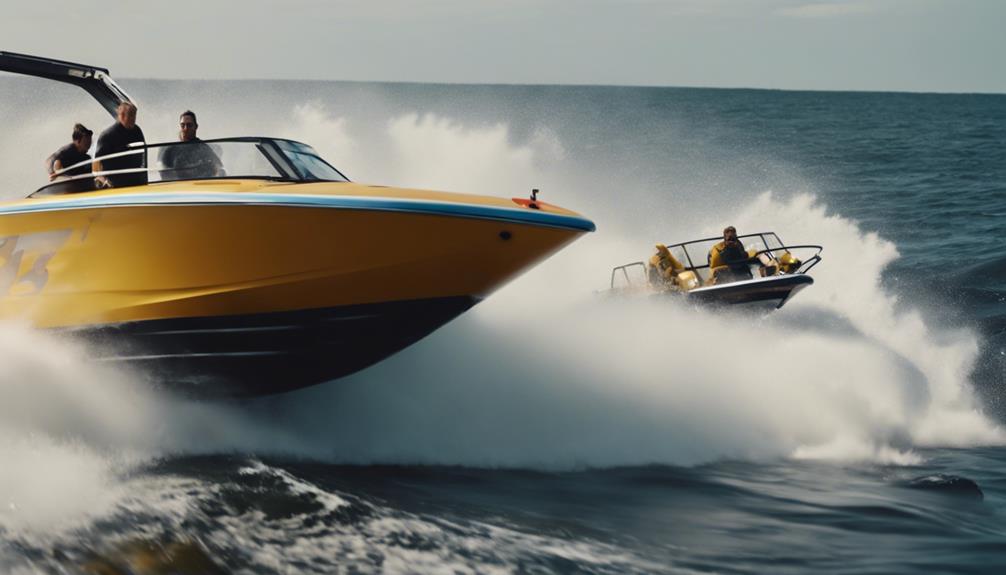
Commonly, jet boats experience porpoising due to a combination of hull design flaws and improper trim adjustments. This bouncing effect often occurs at higher speeds, particularly above 4,000 RPM. One key factor is the rocker in the bottom of the boat, which can destabilize the ride by causing the bow to rise too high, resulting in that annoying bouncing motion on the water.
Weight distribution also plays an essential role in porpoising. If you have heavier passengers sitting at the rear, it can exacerbate the issue, so it's important to balance the weight effectively throughout the boat. Additionally, misalignment of critical components like trim tabs, the ride plate, and the diverter nozzle can greatly impact your boat's handling characteristics, contributing to porpoising.
To help mitigate these problems, you'll want to pay attention to your trim settings and the ride plate angle. Raising the ride plate to a slight upward angle can help reduce tendencies to porpoise. By addressing these common causes, you can enhance your jet boat's performance and enjoy a smoother ride on the water.
Adjustments for Improvement

Making precise adjustments to your jet boat can greatly improve its performance and reduce porpoising.
First, consider adjusting the trim settings. Lowering the trim generally helps decrease porpoising, but find the ideal setting as it varies by your boat model and speed. Aim for a ride plate angle between 2.5 to 3 degrees up from a flat surface to maintain stability while enhancing performance.
Next, check the positioning of the loader and diverter nozzle. Proper water flow management is essential; misalignment can lead to increased porpoising. Regularly monitor RPM fluctuations during testing to assess how effective your adjustments are.
Additionally, examine the weight distribution in your boat. If the weight is too far back, it can exacerbate porpoising. You may want to adjust the weight by relocating gas tanks or heavier gear towards the front. This shift can stabilize the ride considerably.
Weight Distribution Strategies
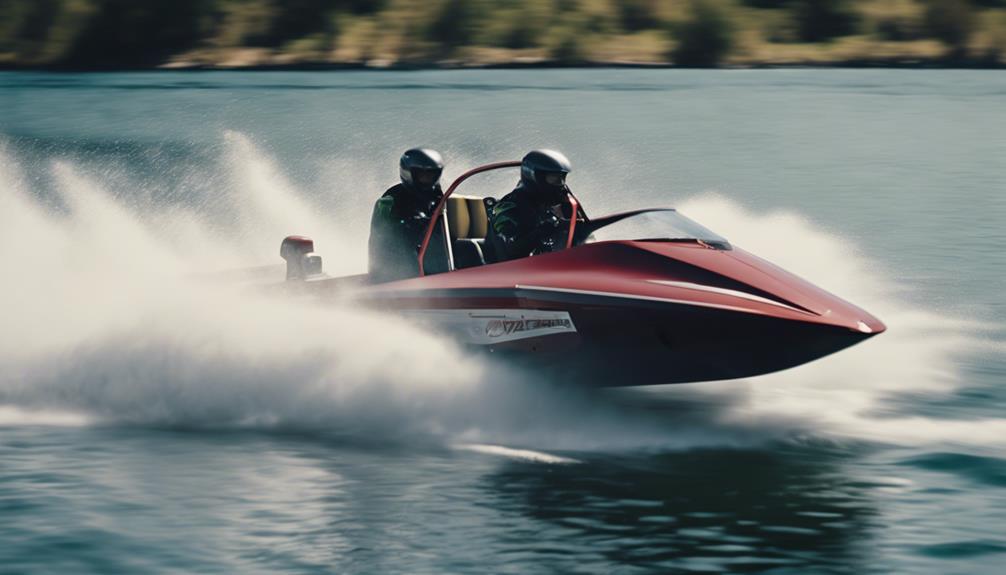
To effectively minimize porpoising, you'll want to focus on maximizing weight distribution throughout your jet boat. Start by evaluating your gear load; verify that it's evenly distributed to maintain a balanced ride.
Heavier items, like anchors and toolbox equipment, should be placed towards the front of the boat. This counterbalances lighter loads in the rear, reducing the chances of uneven riding and subsequent porpoising.
When it comes to passenger seating, consider the weight of your guests. Position heavier passengers towards the front of the boat to enhance stability and further decrease porpoising tendencies. You can also adjust the seating arrangement based on who's onboard, verifying that the overall weight distribution remains ideal.
Lastly, don't forget to move movable weights, such as gas tanks, forward when necessary. Every little adjustment can make a significant difference in achieving a smoother ride.
Testing and Monitoring Performance
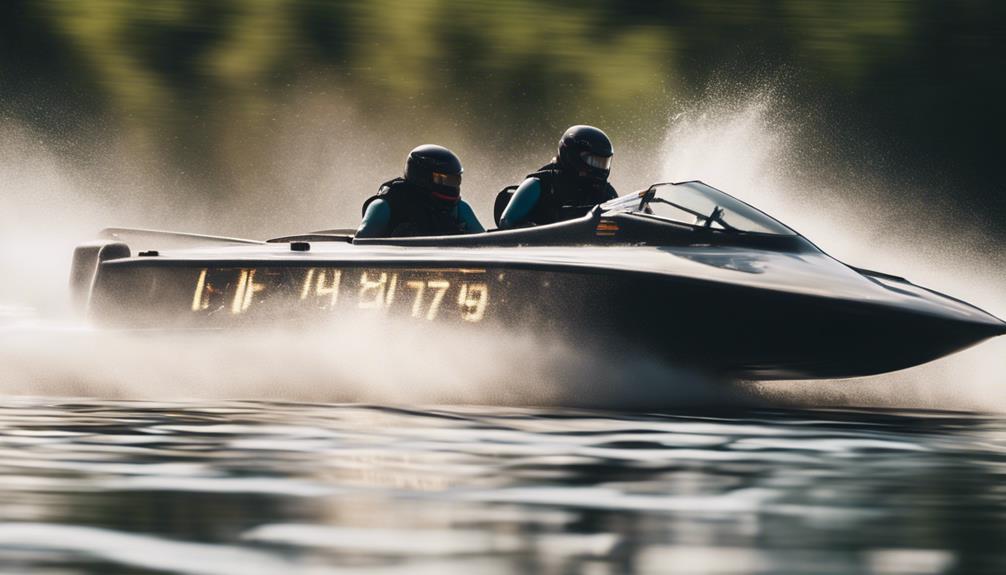
Testing your jet boat's performance after adjustments is essential for understanding how changes impact porpoising behavior at various speeds. Start by conducting water tests to evaluate how the hull interacts with the water. It's important to monitor RPM fluctuations during these tests. This helps you grasp how trim and throttle adjustments affect porpoising dynamics.
While operating your jet boat, pay attention to the hull's water break points. These are significant in identifying specific conditions that may worsen porpoising issues. Make sure you record and compare performance data from multiple tests. This will allow you to refine your tuning and achieve ideal handling characteristics.
Additionally, evaluate the effects of weight distribution and passenger positioning during your tests. These factors can greatly influence porpoising tendencies, so it's essential to assess them carefully.
Frequently Asked Questions
How to Stop a Jet Boat From Porpoising?
To stop your jet boat from porpoising, adjust the trim angle down, redistribute weight towards the front, check the motor height, and consider installing trim tabs for better control and stability while cruising.
What Causes Your Boat to Porpoise?
You're cruising, feeling the thrill, when suddenly your boat starts bouncing. That porpoising can stem from uneven weight distribution, hull design, or improper trim settings, making your ride less enjoyable than it should be.
How to Fix Boat Porpoising?
To fix boat porpoising, adjust the ride plate angle, guarantee proper weight distribution, check trim settings, and inspect cavitation plates. Regularly test after adjustments to monitor improvements and find the best performance for your boat.
Why Is My Boat Bouncing up and Down?
Your boat's bouncing like a pogo stick, right? It's likely due to improper weight distribution, hull design, or trim angle. Tweak those factors, and you'll smooth out your ride in no time!
Could a Jet Boat Not Starting Cause Porpoising Issues?
When experiencing porpoising issues, it’s essential to consider the possibility of a troubleshooting jet boat starting issue. A jet boat not starting can cause performance problems, including porpoising. Ensure that the starting system is functioning correctly to eliminate potential causes of porpoising while operating the boat.
Conclusion
To sum up, solving your jet boat's porpoising problem can greatly enhance your experience on the water.
By understanding the causes, making necessary adjustments, and balancing weight, you'll enjoy smoother sailing.
Stay savvy and systematically test your setup to monitor performance.
Remember, a little effort can lead to a lot of fun!
So, take the time to tackle those troubles, and you'll soon be gliding gracefully over the waves with confidence and control.
Jet Boat
Why Buy a Jet Boat? Discover the Top Reasons!
You'll uncover thrilling adventures and unmatched versatility with a jet boat—discover why this investment is perfect for your water escapades!

Buying a jet boat opens up thrilling adventures and unique navigation experiences. You'll enjoy enhanced safety features, like a jet drive that reduces injury risks while allowing you to explore shallow waters without grounding issues. The exceptional handling and quick acceleration give you a sporty ride, making it perfect for family outings or fishing trips. Plus, jet boats require less maintenance and retain their value over time. With versatility in water conditions, you can uncover hidden coves and set off on unforgettable journeys. Want to discover more reasons why a jet boat's right for you?
Key Takeaways
- Jet boats offer enhanced safety with a jet drive system that reduces risks of propeller injuries and allows for safe shallow water navigation.
- Their shallow draft enables access to hidden fishing spots and secluded areas traditional boats cannot reach, enhancing exploration opportunities.
- Exceptional handling and quick acceleration provide a sporty driving experience, making them ideal for recreational activities and water sports.
- Jet boats are cost-effective, with lower maintenance needs and strong resale value, particularly in aluminum models, ensuring long-term value.
Safety Features of Jet Boats
When it comes to safety on the water, jet boats offer impressive features that greatly reduce risks for everyone onboard and nearby. One of the standout safety features is the jet drive system, which eliminates the traditional propeller found in other boats. This internal jet drive impeller not only enhances performance but also considerably minimizes the risk of propeller injuries to swimmers and skiers in the water.
Additionally, the design of jet boats focuses on reducing hazards for passengers and those enjoying the water. Since the jet drive is housed entirely within the hull, it provides an extra layer of protection against accidents. This design allows you to navigate in shallow water without the fear of grounding, making it safer to explore lakes and rivers.
Moreover, jet boats maintain stability and control in various water conditions, contributing to a secure boating experience overall. With these advanced safety features, you can feel confident knowing that jet boats prioritize the well-being of everyone involved.
Whether you're cruising with friends or enjoying a day on the lake, these safety measures guarantee a fun and secure outing on the water.
Shallow Water Navigation
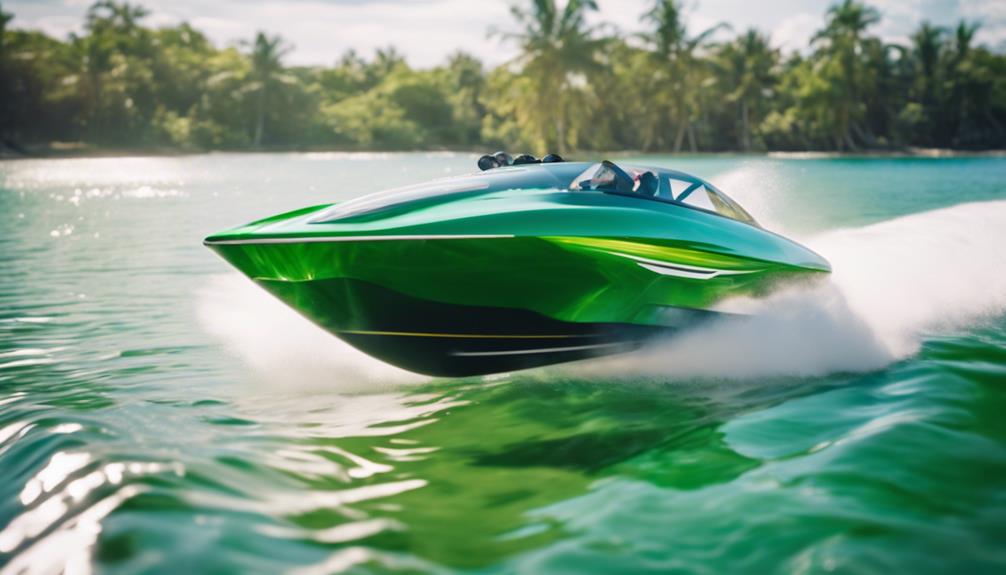
If you love exploring shallow lakes and hidden areas, a jet boat is a game changer.
With a shallow draft, you can navigate with ease and access spots that traditional boats can't.
You'll unveil new adventures and enjoy recreational activities in places you never thought possible.
Ideal for Shallow Lakes
Jet boats are perfect for maneuvering shallow lakes, thanks to their shallow draft that lets you access areas traditional boats can't reach. With a draft typically ranging from 12 to 17 inches, these boats glide effortlessly through shallower waters. This unique design means you can explore places where conventional vessels would struggle or even get stuck.
One of the biggest advantages of jet boats is their ability to operate effectively in as little as 3 inches of water at full throttle. Unlike traditional boats with protruding propellers, jet boats draw water from underneath and expel it from the stern. This feature minimizes the risk of damaging the boat's underside, allowing you to navigate without worry.
Moreover, the absence of an outdrive or propeller remarkably enhances your versatility in different water conditions. You won't have to stress about grounding or getting stuck in shallow areas, making your outings much more enjoyable.
Access to Hidden Areas
Exploring hidden areas becomes a breeze with a jet boat, allowing you to navigate remote rivers, lakes, and streams that traditional boats simply can't reach. Thanks to their shallow draft, typically ranging from 12 to 17 inches, jet boats can skim over waters as shallow as 3 inches at full throttle without risking damage. This unique feature opens up a world of exploration that many boaters miss out on.
You won't have to worry about an external propeller getting in the way either, as jet boats operate safely in shallow conditions, minimizing the risk of grounding or propeller strikes. This safety aspect is especially appealing for those keen to fish in less-fished areas.
With their nimble handling and quick acceleration, jet boats can efficiently maneuver around tight turns and obstacles in shallow waters, making your adventures more exciting and less restrictive. Whether you're seeking secluded fishing spots or hidden coves, a jet boat gives you the freedom to explore areas that are otherwise inaccessible.
Investing in a jet boat means embracing new adventures and discovering the beauty of nature like never before.
Navigate With Ease
Maneuvering shallow waters becomes effortless with a jet boat, allowing you to access hidden gems that other vessels can't reach. These boats operate effectively in depths as shallow as 3 inches, making them perfect for exploring lakes, rivers, and streams.
Unlike traditional propeller-driven vessels, jet boats eliminate the risk of damaging a propeller in rocky or low-water conditions, giving you the freedom to steer with confidence. With a draft ranging from 12 to 17 inches, jet boats glide over obstacles, effortlessly handling tricky spots that would ground other boats.
This unique capability not only broadens your range of accessible locations but also enhances your recreational options. Imagine fishing in secluded spots or enjoying day trips in diverse environments that others can only dream about reaching.
Jet boats are designed for versatility, allowing you to explore areas that would challenge propeller-driven vessels. So, if you're looking for a way to make the most of your time on the water, a jet boat is your best bet for maneuvering shallow waters and discovering the beauty that lies beneath the surface.
Exceptional Handling and Performance
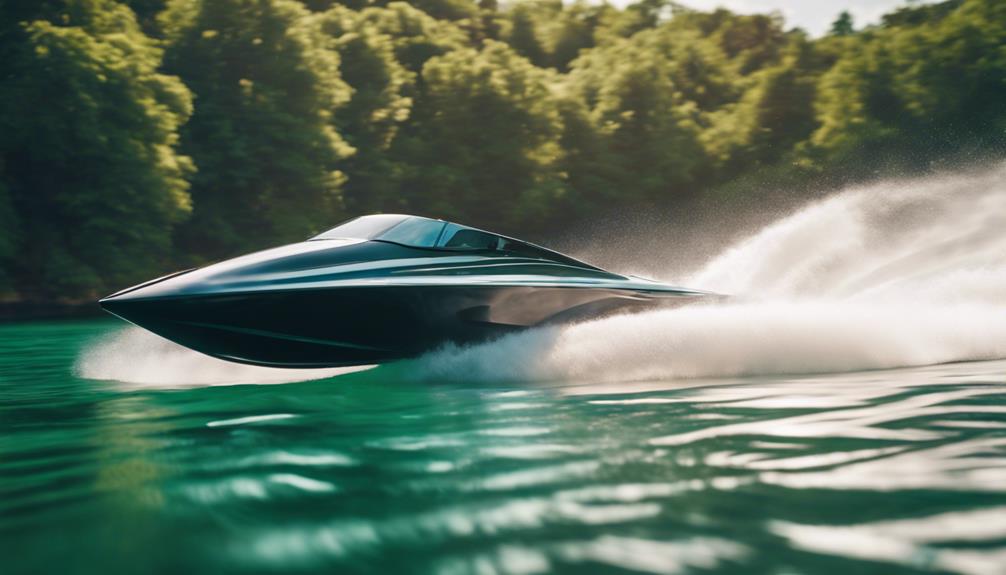
With their impressive acceleration and agile handling, these boats offer a sporty driving experience that keeps you in control, even in challenging conditions.
Jet drives give you the edge with quick planing capabilities, ensuring you can hit top speeds without the annoying bow-rise typical of many traditional boats. You'll love the responsive steering, which uses water nozzles for maneuverability that rivals a sportscar, making every turn feel exhilarating.
- Experience the thrill of quick acceleration and sharp turns.
- Navigate shallow waters with ease, reaching places others can't.
Jet boats truly excel in exceptional handling and performance, designed not just for leisure but also for those who crave speed and agility.
Their shallow draft allows access to hidden gems on the water, and the absence of an exposed propeller means less drag and a more efficient ride.
Whether you're racing or exploring, you'll appreciate the competitive edge that jet boats bring to your adventures.
Embrace the excitement and elevate your boating experience with a vessel that delivers unparalleled performance.
Versatile Usage Scenarios

When you think about using a jet boat, you'll find it's perfect for family outings, fishing trips, and exploring shallow waters.
Its quick acceleration and agility make it an ideal choice for recreational activities and adventure.
Plus, with the ability to navigate tight spaces, you can easily enjoy day trips with friends or seek out the best fishing spots.
Family Recreational Activities
Jet boats offer families the perfect blend of adventure and safety, making them ideal for a variety of recreational activities on the water. With their shallow draft, you can navigate lakes and rivers with low water levels, allowing you to explore hidden gems without worry. The quick acceleration and superior handling mean you'll experience thrilling moments during family outings, seamlessly accommodating water sports like wakeboarding and tubing.
Imagine the joy of:
- Laughing together as you tube across the waves
- Creating unforgettable memories while wakeboarding
Safety is a top priority with jet boats, as their design eliminates exposed propellers, greatly reducing the risk of injury to swimmers and skiers. Plus, the ample space onboard makes it easy to invite friends and family for social outings, fostering memorable shared experiences.
The versatility of jet boats lets you engage in various activities, from exhilarating water sports to relaxing cruises. With one boat, you can maximize your enjoyment and adventure possibilities, ensuring every family gathering is one for the books.
Choose a jet boat for your next family recreational activity, and plunge into the excitement!
Fishing Adventures
Fishing adventures become more accessible and exciting with a jet boat, allowing you to reach remote spots that traditional boats can't. Jet boats, like the Yamaha 190 FSH, boast a shallow draft, letting you navigate in just 12 to 17 inches of water. This means you can access hidden fishing holes in lakes and rivers that others might overlook.
With their quick acceleration and superior handling, jet boats also help you get to your favorite fishing locations faster. You won't waste time battling currents or struggling with shallow areas; instead, you can focus on what really matters—catching fish. Plus, the impeller system greatly reduces the risk of propeller injuries, ensuring a safer environment for both you and any swimmers nearby.
The versatility of jet boats doesn't end with fishing. You can easily switch gears and enjoy water sports, making your outings more dynamic and enjoyable. So, whether you're chasing after bass or simply soaking up the sun, a jet boat offers a unique and thrilling experience, elevating your fishing adventures to new heights.
Shallow Water Exploration
Exploring shallow waters becomes an exhilarating adventure with a jet boat, as its shallow draft lets you access hidden gems that traditional boats can't reach.
With a jet boat, you can glide through rivers, lakes, and streams, uncovering secret spots that few have experienced. The absence of an external propeller means you won't damage fragile ecosystems, making your waterway exploration not only thrilling but also environmentally friendly.
Imagine the excitement of:
- Discovering secluded fishing holes where the big catch awaits.
- Skiing in pristine waters surrounded by breathtaking scenery.
The versatility of jet boats is a game-changer for any adventure seeker. You can navigate in just a few inches of water, allowing you to explore tight spaces that other boats simply can't access.
Plus, their superior handling and quick acceleration make every outing a unique experience.
Maintenance and Care Tips

To keep your jet boat running smoothly and safely, regular maintenance and inspections are essential. Start by thoroughly cleaning the jet system after each use to prevent debris build-up, which can impair functionality and damage the impeller. Regularly inspect the impeller and reverse gate to guarantee peak performance and safety.
Routine engine maintenance is important, so check the oil, air filters, and spark plugs regularly. This not only prolongs the life of the engine but also maintains overall performance. Don't forget to examine the hull for scratches or damage; maintaining its integrity helps guarantee water efficiency and prevents further deterioration.
Additionally, monitoring fuel levels and quality is critical to avoid performance issues. Low-quality fuel can affect how your jet boat operates, leading to potential problems down the line.
Cost Considerations and Value
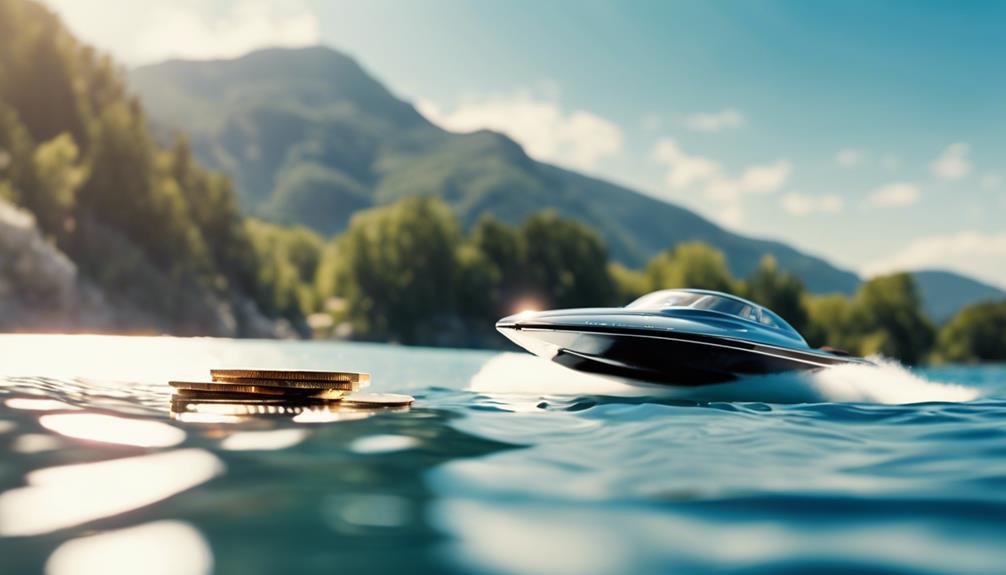
Understanding the costs associated with owning a jet boat can help you make an informed decision about your investment while enjoying the benefits of lower maintenance expenses and impressive resale value. When you consider cost considerations, jet boats, particularly aluminum boats, stand out for their affordability and long-term value.
You'll save money on maintenance due to their simpler mechanical systems.
Aluminum boats typically retain over 85% of their value, ensuring a solid return when you're ready to sell.
The strong resale market means you can easily upgrade without losing your investment.
While fuel consumption may be higher, the durability and corrosion resistance of aluminum jet boats mean fewer repairs and replacements over time.
This longevity translates to significant savings, making them an economically attractive option for performance seekers.
The initial affordability, combined with impressive resale value, makes owning a jet boat a savvy financial decision.
You can enjoy thrilling adventures on the water while feeling secure in your investment's worth, knowing that you'll likely recover a significant portion of your costs when it's time to move on.
Frequently Asked Questions
Why Do People Buy Jet Boats?
People buy jet boats for their unmatched handling and quick acceleration, allowing you to explore shallow waters easily. Their safety features protect swimmers, while customizable options cater to various activities like fishing, enhancing your experience.
What Is Good About Jet Boats?
With a draft of just 12 to 17 inches, you can access shallow waters that traditional boats can't reach. Jet boats offer safety, agility, and versatility, making them perfect for thrilling adventures and family fun.
What Is the Benefit of a Jet Boat Vs Prop?
When comparing a jet boat to a prop boat, you'll enjoy superior speed and handling, easier navigation in shallow waters, and a safer environment for swimmers, all while minimizing maintenance issues with fewer exposed components.
What Are the Downsides of Jet Boats?
Imagine a roaring jet ski racing through the waves; that thrill comes with trade-offs. Jet boats can drain your wallet with high fuel costs, maintenance needs, and noise levels that might disrupt your peaceful day on the water.
What Are the Top Reasons to Consider a Jet Boat Despite Its Pros and Cons?
When considering the pros and cons of jet boats, it’s important to weigh the benefits of their incredible speed and maneuverability against the potential drawbacks of high fuel consumption and noise levels. However, the thrill of riding a jet boat and the access to shallow waters make it a top choice for many adrenaline-seeking water enthusiasts.
Conclusion
In a world where adventure awaits, a jet boat is your ticket to freedom on the water.
With its unmatched safety features and ability to glide through shallow waters, it opens up a domain of possibilities for exploration.
Whether you're racing across lakes or enjoying a tranquil sunset cruise, you'll appreciate the exceptional handling and performance.
Investing in a jet boat isn't just buying a vessel; it's embracing a lifestyle filled with excitement and unforgettable memories.
-

 Vetted6 months ago
Vetted6 months ago15 Best Surfboards of 2025: Ride the Waves Like a Pro
-

 Beach Body6 months ago
Beach Body6 months agoGlow Safely With Top Tanning Sunscreens
-

 Beach Body6 months ago
Beach Body6 months agoMaximize Your Glow Before Vacation
-

 Beach Body6 months ago
Beach Body6 months agoWhat Is the Beach Body Total Solution Pack? Find Out!
-

 Vetted6 months ago
Vetted6 months ago15 Best Surfing Pikachu V Cards That Every Collector Needs in Their Deck
-

 Vetted6 months ago
Vetted6 months ago14 Best Surfing Books to Inspire Your Next Wave Adventure
-

 Jet Boat6 months ago
Jet Boat6 months agoAre Jet Boats Dangerous? What You Need to Watch Out For!
-

 Surfing Waves6 months ago
Surfing Waves6 months agoDive Into Adventure: 7 Unique Water-Based Activities Unveiled









